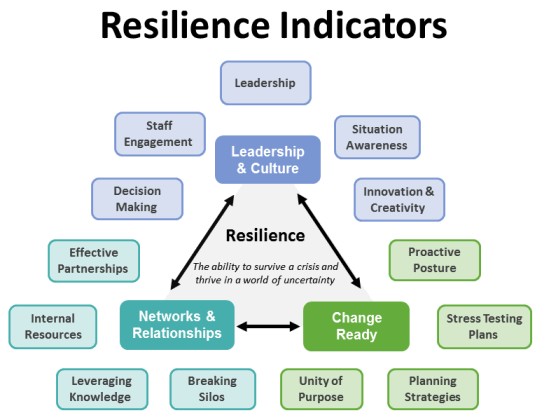What makes a resilient organization?

There is no one formula for how to design a perfectly resilient organization. As resilience researchers, we have found that any organization, regardless of size or structure, can build planned and adaptive resilience capabilities. Resilience relates more to how an organization can access and utilize resources when it needs them. For example, large multinational corporations can be resilient, drawing from their large pool of resources. But they can also suffer from being less responsive and agile. Small businesses have fewer resources, but if they are well networked and connected with other organizations, they can access a large pool of resources when required.
An organization’s resilience is drawn from its planned and adaptive capabilities. Organizations that invest in their planned resilience capabilities are able to sense change as it emerges, take action to minimize the downside risk, and to extract maximum upside. They are able to prevent many crises from ever occurring, and when crises do occur, they manage them responsively and effectively. However, planned resilience capabilities will only get an organization so far. No crisis ever fits the plan, and organizations inevitably need to find ways to adapt and evolve. Being both planned and adaptive is the key to resilience.
Resilience is less dependent on the structural design of the organization than it is on the relationship between people and groups within that organization. Different resilience challenges are faced by organizations operating in different sectors. Organizations in highly regulated environments can sometimes find themselves constrained in their ability to implement solutions at short notice, yet organizations operating in highly competitive environments may have more incentive to innovate.
Over 10 years, our research programme Resilient Organizations has grown to involve more than 35 active researchers, bringing together people with diverse expertise, perspectives and ways of framing the organizational resilience challenge. We have identified 13 indicators to assess the resilience of an organization.

No matter what type of organization, large or small, for-profit or not-for-profit, these 13 indicators of resilience apply:
1. Leadership: Strong crisis leadership to provide good management and decision making during times of crisis, as well as continuous evaluation of strategies and work programs against organizational goals.
2. Staff Engagement: The engagement and involvement of staff who understand the link between their own work, the organization's resilience, and its long term success. Staff are empowered and use their skills to solve problems.
3. Situation Awareness: Staff are encouraged to be vigilant about the organization, its performance and potential problems. Staff are rewarded for sharing good and bad news about the organization including early warning signals and these are quickly reported to organizational leaders.
4. Decision Making: Staff have the appropriate authority to make decisions related to their work and authority is clearly delegated to enable a crisis response. Highly skilled staff are involved, or are able to make, decisions where their specific knowledge adds significant value, or where their involvement will aid implementation.
5. Innovation and Creativity: Staff are encouraged and rewarded for using their knowledge in novel ways to solve new and existing problems, and for utilising innovative and creative approaches to developing solutions.
6. Effective Partnerships: An understanding of the relationships and resources the organization might need to access from other organizations during a crisis, and planning and management to ensure this access.
7. Leveraging Knowledge: Critical information is stored in a number of formats and locations and staff have access to expert opinions when needed. Roles are shared and staff are trained so that someone will always be able to fill key roles.
8. Breaking Silos: Minimisation of divisive social, cultural and behavioural barriers, which are most often manifested as communication barriers creating disjointed, disconnected and detrimental ways of working.
9. Internal Resources: The management and mobilisation of the organization's resources to ensure its ability to operate during business as usual, as well as being able to provide the extra capacity required during a crisis.
10. Unity of Purpose: An organization wide awareness of what the organization's priorities would be following a crisis, clearly defined at the organization level, as well as an understanding of the organization's minimum operating requirements.
11. Proactive Posture: A strategic and behavioural readiness to respond to early warning signals of change in the organization's internal and external environment before they escalate into crisis.
12. Planning Strategies: The development and evaluation of plans and strategies to manage vulnerabilities in relation to the business environment and its stakeholders.
13. Stress Testing Plans: The participation of staff in simulations or scenarios designed to practice response arrangements and validate plans.
Within these 13 indicators, our team believes that some indicators are more potent than others.
In my book, Resilient Organizations I take you through five key ingredients for creating a resilient organization.




